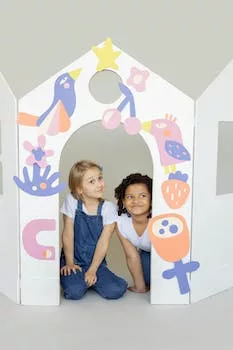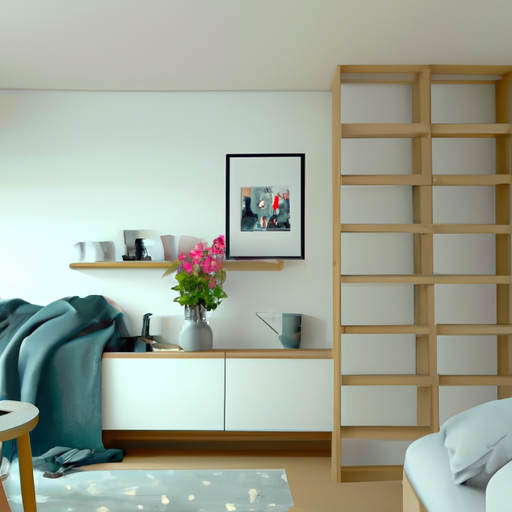Maximizing Space and Functionality for Family Living
Creating a home that is perfect for family living requires careful planning and consideration of various design elements. One of the most important aspects to focus on is maximizing space and functionality to ensure that the home is comfortable, practical, and enjoyable for all family members. This article will discuss several design considerations that can help you achieve this goal.
First and foremost, it is essential to consider the layout of your home. A well-designed floor plan can significantly impact the overall functionality and flow of the space. Open-concept layouts are particularly popular for family living, as they allow for easy communication and interaction between family members. This design style also helps to create a sense of spaciousness, even in smaller homes. When planning your layout, consider the needs and preferences of your family members, as well as any potential future changes, such as the arrival of a new baby or the departure of a grown child.
Another important aspect of maximizing space and functionality is the efficient use of storage. Families tend to accumulate a lot of belongings over time, and having ample storage options can help to keep the home organized and clutter-free. Built-in storage solutions, such as custom cabinetry, shelves, and closets, can be both practical and visually appealing. Additionally, multi-functional furniture pieces, such as beds with built-in storage or ottomans that double as seating and storage, can be a great way to save space and maintain a clean, uncluttered environment.
In addition to storage, it is crucial to consider the functionality of each room in your home. For example, the kitchen is often considered the heart of the home and should be designed with family living in mind. This may include incorporating a large island with seating for casual meals and conversation, as well as ample counter space for meal preparation and serving. Additionally, durable and easy-to-clean materials, such as quartz countertops and stainless steel appliances, can help to ensure that your kitchen remains functional and attractive for years to come.
Similarly, living and family rooms should be designed with comfort and relaxation in mind. This may involve selecting comfortable seating options, such as sofas and chairs with deep cushions and supportive backs, as well as creating designated areas for various activities, such as watching television, playing games, or reading. Additionally, incorporating elements such as built-in bookshelves or a fireplace can help to create a cozy, inviting atmosphere that is perfect for family gatherings and relaxation.
Finally, it is important to consider the outdoor spaces of your home, as these areas can significantly contribute to the overall enjoyment and functionality of your living environment. Designing outdoor spaces with family living in mind may involve creating designated areas for play, relaxation, and dining. This can be achieved through the use of landscaping, outdoor furniture, and amenities such as a playset, fire pit, or outdoor kitchen.
In conclusion, creating a home that is perfect for family living involves careful consideration of various design elements, including layout, storage, room functionality, and outdoor spaces. By focusing on these aspects and tailoring your home design to the needs and preferences of your family members, you can create a living environment that is comfortable, practical, and enjoyable for all.
Integrating Safety Features and Child-Friendly Design Elements

Creating a home that is perfect for family living requires careful consideration of various design elements, particularly when it comes to integrating safety features and child-friendly design elements. A well-designed family home should not only be aesthetically pleasing but also functional, comfortable, and safe for all members of the family, including young children and elderly relatives. In this article, we will discuss some essential design considerations to help you create a home that is perfect for family living.
One of the most critical aspects of designing a family-friendly home is ensuring that it is safe for all occupants. This includes incorporating safety features such as smoke detectors, carbon monoxide detectors, and fire extinguishers in strategic locations throughout the house. Additionally, it is essential to have a well-thought-out escape plan in case of emergencies, with clearly marked exits and escape routes.
Another crucial safety consideration is the prevention of accidents, particularly for young children. This can be achieved by installing safety gates at the top and bottom of staircases, using window guards to prevent falls, and placing covers on electrical outlets. Additionally, it is essential to choose furniture with rounded edges and avoid glass coffee tables or other items that may pose a risk of injury.
In addition to safety features, it is essential to incorporate child-friendly design elements into your home. One of the most effective ways to do this is by creating designated play areas for children. This can be achieved by allocating a specific room or section of the house for toys, games, and other activities, ensuring that children have a safe and dedicated space to play and explore. This not only helps to keep the rest of the house tidy but also encourages children to develop their creativity and imagination.
Another essential aspect of child-friendly design is the use of durable and easy-to-clean materials. This includes choosing flooring options such as hardwood, laminate, or tile, which are more resistant to spills and stains than carpet. Similarly, it is essential to select furniture and upholstery that can withstand the wear and tear of daily family life, such as leather or microfiber sofas and chairs.
Storage is another critical consideration when designing a family-friendly home. Adequate storage solutions can help to keep the house organized and clutter-free, making it a more pleasant and functional living space for all members of the family. This can be achieved by incorporating built-in storage solutions such as closets, shelves, and cabinets, as well as utilizing multi-functional furniture such as beds with built-in storage or ottomans that double as storage containers.
Lighting is another essential design element that can significantly impact the overall atmosphere and functionality of a family home. It is crucial to ensure that all areas of the house are well-lit, with a combination of ambient, task, and accent lighting to create a warm and inviting living space. Additionally, it is essential to consider the use of energy-efficient lighting options such as LED bulbs, which can help to reduce energy consumption and save on utility bills.
Finally, it is essential to create a home that is adaptable and flexible to the changing needs of a growing family. This may include designing rooms that can easily be converted from a nursery to a home office or guest room, or incorporating open-plan living spaces that can be reconfigured to accommodate different activities and functions.
In conclusion, creating a home that is perfect for family living requires careful consideration of various design elements, including safety features, child-friendly design elements, and functional living spaces. By incorporating these considerations into your home design, you can create a comfortable, safe, and enjoyable living environment for your entire family.
Balancing Aesthetics and Practicality for a Family-Friendly Home
Creating a home that is perfect for family living requires a delicate balance between aesthetics and practicality. A well-designed family home should not only be visually appealing but also functional and comfortable for all members of the family. This article will discuss some key design considerations to help you achieve this balance and create a home that is both beautiful and family-friendly.
One of the most important aspects of designing a family-friendly home is ensuring that it is adaptable to the changing needs of your family. As your children grow and your family dynamics evolve, your home should be able to accommodate these changes with minimal disruption. This can be achieved by incorporating flexible spaces and multi-functional furniture into your design. For example, a spare bedroom can be easily transformed into a home office or playroom, while a large dining table can double as a workspace for homework or crafts.
Another crucial factor to consider when designing a family home is durability. With children and pets in the mix, it’s essential to choose materials and finishes that can withstand the wear and tear of daily life. Opt for easy-to-clean surfaces, such as wipeable paint and stain-resistant fabrics, to keep your home looking fresh and well-maintained. Additionally, investing in high-quality, durable furniture will ensure that your pieces last for years to come, saving you money in the long run.
Storage is another key element of a well-designed family home. Clutter can quickly accumulate in a busy household, so it’s essential to have ample storage solutions to keep your space organized and functional. Built-in storage, such as shelves, cabinets, and under-stair storage, can be a great way to maximize space and keep your belongings out of sight. Additionally, consider incorporating storage solutions that are easily accessible for children, such as low shelves and toy boxes, to encourage them to take responsibility for their belongings and keep their spaces tidy.
Safety should also be a top priority when designing a family-friendly home. This includes ensuring that your home is free from potential hazards, such as sharp edges, slippery surfaces, and unsecured furniture. Childproofing measures, such as installing safety gates, outlet covers, and cabinet locks, can help to create a safe environment for your little ones to explore and play. Additionally, consider incorporating safety features such as smoke detectors, carbon monoxide detectors, and a security system to protect your family and give you peace of mind.
Finally, creating a home that is perfect for family living means designing spaces that encourage connection and togetherness. Open-plan living areas, where the kitchen, dining, and living spaces flow seamlessly into one another, can be a great way to promote family interaction and make it easy to keep an eye on children while you cook or work. Additionally, creating dedicated spaces for family activities, such as a games room or outdoor play area, can help to foster a sense of unity and encourage quality family time.
In conclusion, designing a home that is perfect for family living requires a careful balance between aesthetics and practicality. By considering factors such as adaptability, durability, storage, safety, and togetherness, you can create a beautiful and functional space that meets the needs of your family and evolves with you over time. With thoughtful planning and attention to detail, you can create a home that is not only visually appealing but also a comfortable and nurturing environment for your family to grow and thrive.
Q&A
Question 1: What are the key design considerations for creating a family-friendly home?
Answer 1: The key design considerations for a family-friendly home include creating open and flexible living spaces, ensuring safety and functionality, incorporating ample storage solutions, and designing comfortable and durable interiors.
Question 2: How can I design a home that accommodates the needs of both children and adults?
Answer 2: To design a home that accommodates the needs of both children and adults, consider incorporating multi-functional spaces, creating designated play areas for children, choosing durable and easy-to-clean materials, and ensuring that the home layout promotes family interaction and supervision.
Question 3: What are some ways to create a safe and secure environment for a family home?
Answer 3: To create a safe and secure environment for a family home, consider installing safety features such as smoke detectors and security systems, using childproofing measures like outlet covers and safety gates, ensuring proper lighting both indoors and outdoors, and selecting furniture with rounded edges and non-toxic materials.
Conclusion
In conclusion, creating a home that is perfect for family living involves thoughtful design considerations that prioritize functionality, comfort, and safety. By incorporating open-concept layouts, versatile spaces, ample storage, and age-appropriate features, a home can cater to the evolving needs of a growing family. Additionally, integrating outdoor spaces and sustainable elements can enhance the overall living experience and contribute to a healthier, more enjoyable family environment.


